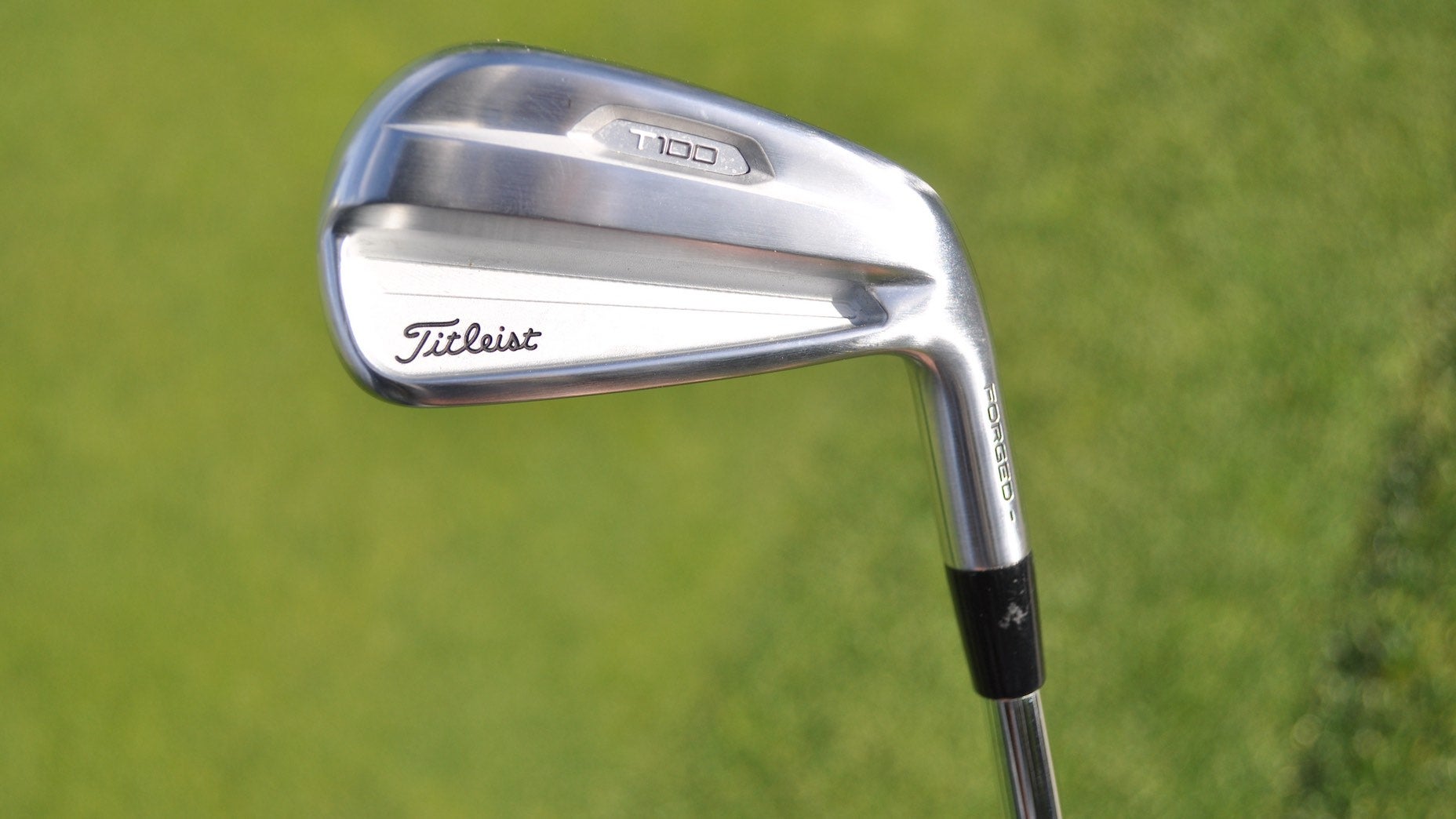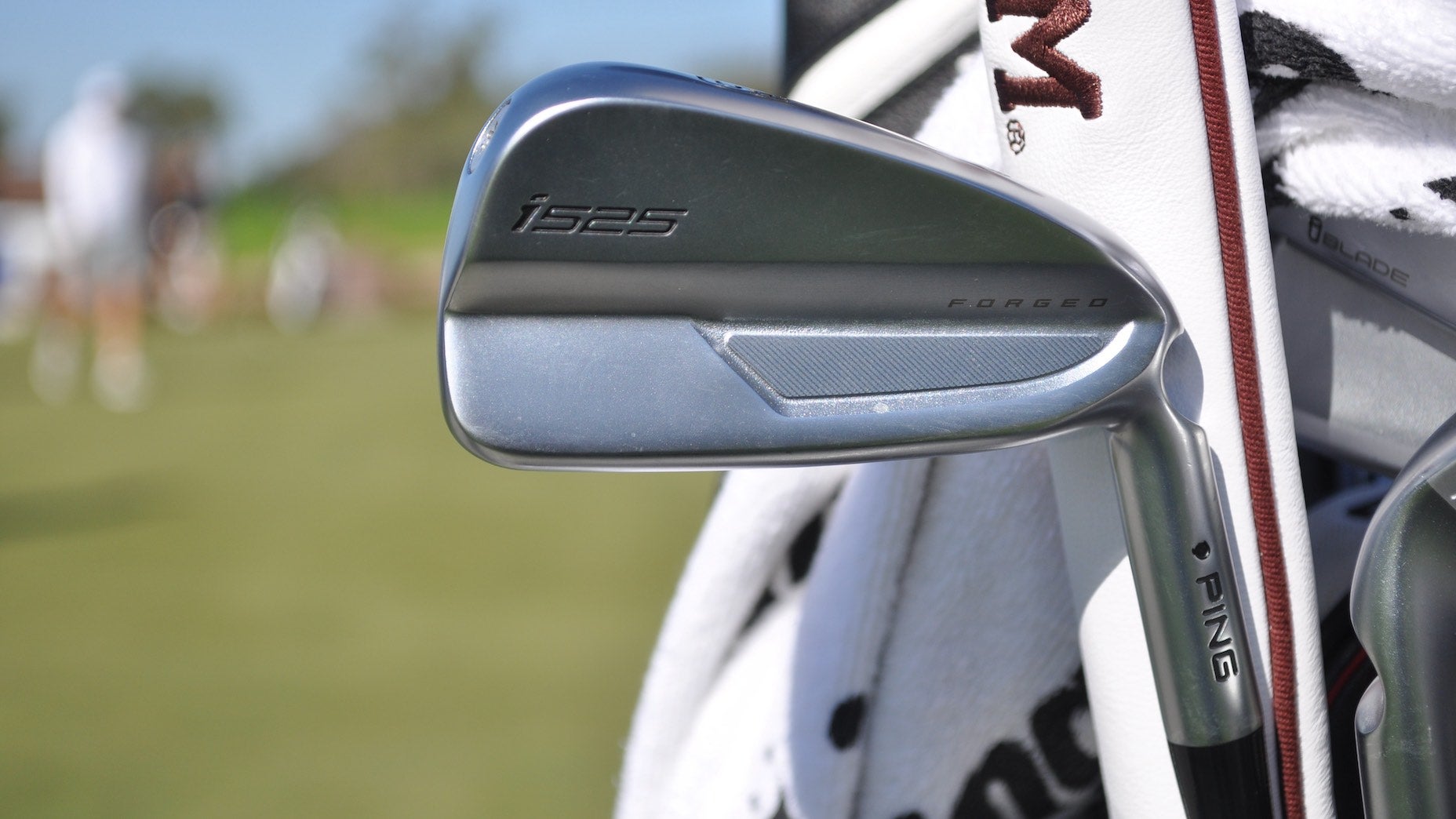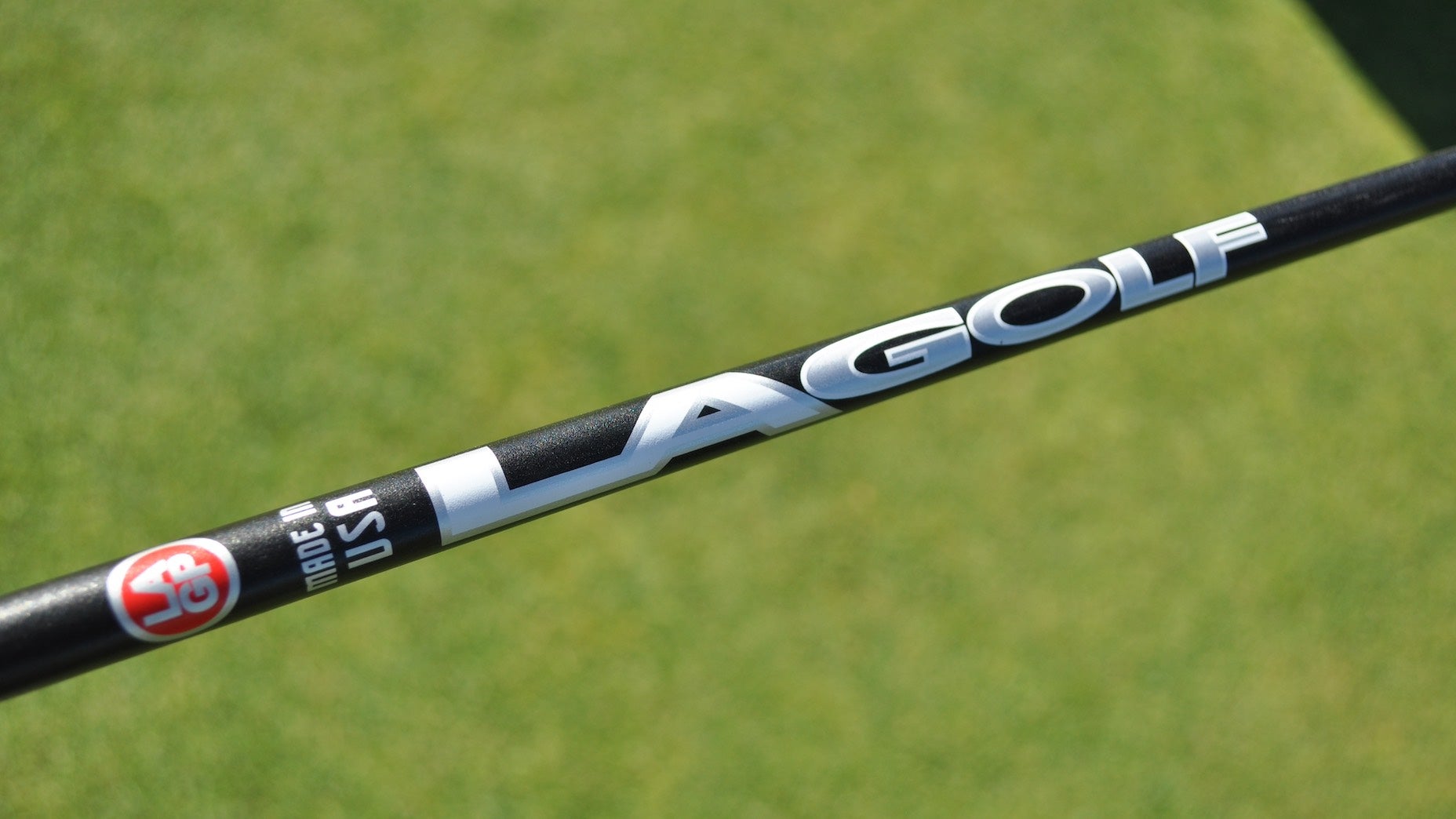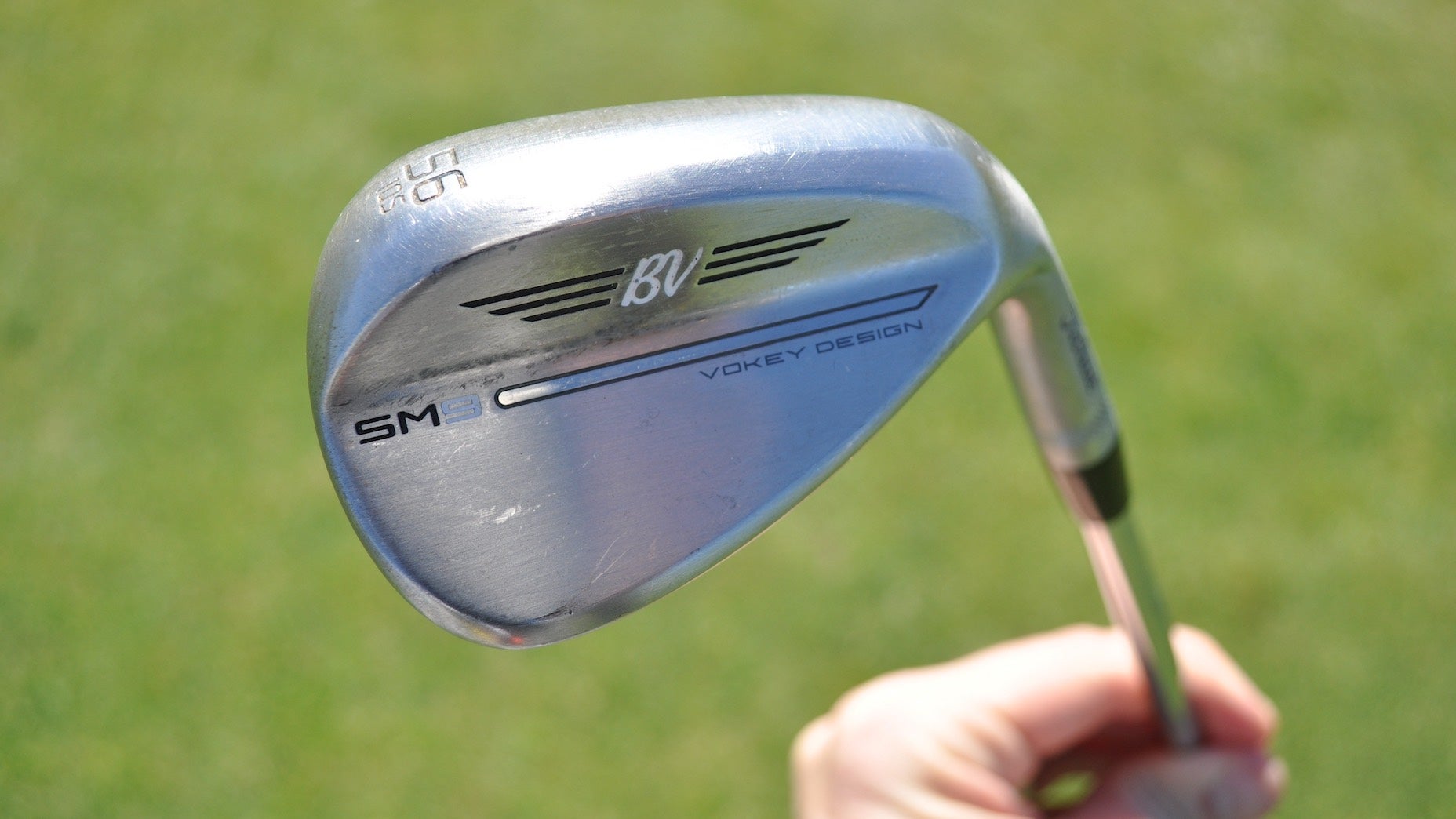
Johnson’s first start of 2022 came with a new TaylorMade Stealth Plus driver.
Jonathan Wall/GOLF
Welcome to Wall-to-Wall Equipment, the Monday morning gear wrap-up in which GOLF equipment editor Jonathan Wall takes you through the latest trends, rumors and breaking news.
Fantastic feel
Dustin Johnson had the same question as most weekend golfers when he hit TaylorMade’s Stealth driver for the first time: How would the 60-layer Carbon Twist Face sound and feel compared to the titanium construction he’d come to rely on?
It didn’t take Johnson long to get an answer to his question.
“For me, so long as it sounds good, it’s going to feel right to me,” Johnson told GOLF.com about his 10.5-degree Stealth Plus driver. “The sound is solid out of the middle, and I can tell when it’s coming off the toe or heel, so the feedback is there. Even though it’s a different material, it still has that titanium feel and sound at impact.”
Johnson also confirmed his mishits produced consistently faster ball speed numbers than his previous driver. The spin rates across the entire face were more reliable as well.
“It’s a better driver for sure,” Johnson said. “That’s all I’m looking for when I’m testing. If it does a few things noticeably better than my other driver, I’ll generally give it a chance.”
In a video TaylorMade posted on Twitter, Johnson can be overheard saying “that’s about perfect” as he smoothes one down the range with 180 mph ball speed.
The speed is a nice-to-have, but in DJ’s case, there’s more to Stealth than generating extra ball speed.
Pair of 4s

Justin Thomas’ new Titleist T100 4-iron.
Jonathan Wall/GOLF
A stone’s throw from Torrey Pines, the Titleist Performance Institute (TPI) is a popular spot during the Farmer Insurance Open. Pros are able to get work done behind the scenes without the usual prying eyes.
Max Homa was one of those pros who put in the time with Titleist Tour rep JJ VanWezenbeeck early in the week. In addition to adding a new Fujikura Ventus Black driver to his TSi3 driver, Homa swapped out his Titleist 620MB 4-iron for a T100 version after attempting one shot at TPI.
“Max was looking for some performance at the top of his iron set, so I had him try a downhill shot with his MB 4-iron,” said VanWezenbeeck. “He couldn’t hit the shot with his MB, but he could pull it off with the T100. That was a big moment as he tested T100.”
Along with picking up ball speed and mishit protection, Homa was able to achieve his preferred 4-iron peak height by weakening the head 1 degree.
Justin Thomas also added a new T100 4-iron to the bag following testing at home during the offseason. Unlike Homa, Thomas was already in T100 (previous version) and found the updated version to have better aesthetics, feel and launch conditions during testing.
“He tried the T100S as well, but the ball speed was too much.” VanWezenbeeck said. “The T100 was just right for his game and fits that 235-240 yard carry gap in his bag.”
Cam Champ’s new Ping weapon

Champ’s new Ping i525 3-iron could approach 300 yards of carry.
Jonathan Wall/GOLF
Cameron Champ switched out his Ping i500 3- and 4-iron for i525 prototypes — and gained ball speed. It’s a good problem to have for a guy who was already at 292 yards of carry and 177 mph ball speed with the 3-iron. Now Champ is inching closer to 180 mph ball speed, a number some pros are recording with their driver.
“I’ve seen him get to 177, 178 mph ball speed,” Ping Tour rep Kenton Oates told GOLF.com. “With the new prototype, he’s gained close to a couple miles per hour of additional ball speed, so I think he can get to 180. He’ll lose some distance this week playing on the coast, but by the time he gets to Phoenix, he’ll be able to get that TrackMan number where he tees it up and can catch it 290 yards carry no problem.”
Of course, the change to i525 was about more than gaining ball speed.
“The look was also cleaner with a little bit less offset, and the sound was a lot more muted and less loud,” Oates said. “The prototype started to sound more like his iBlades for him.”
Ping refrained from offering full details on the iron design, but it’s safe to assume i525 is a replacement for i500. The hollow blade-style i500 featured a C300 managing-steel face that gave it metal-wood-like speed. If Champ is seeing a slight uptick in speed, it’s very likely an active face is still part of the equation.
The Bryson effect

Perez spoke to DeChambeau about his experiences with graphite before making the switch.
Jonathan Wall/GOLF
Graphite remains a distant second to steel in the iron market, but Bryson DeChambeau’s recent success with a full set of LAGP graphite-shafted clubs has made some of his tour colleagues stand up and take notice, Pat Perez included.
During the offseason, Perez spoke to DeChambeau about his iron setup and was intrigued by the concept of replacing his steel shafts with a product that could tighten dispersion and reduce vibrations.
“I talked to Bryson because he’s so involved in the numbers side of things in golf and thinking outside the box,” Perez told GOLF.com. “He’s the perfect guy to ask about anything in golf because he’s going to study it through and through.”
DeChambeau’s positive feedback on the LAGP iron shaft was enough to convince Perez to give it a chance before the season restarted.
“I had never hit graphite up until that point,” Perez said. “But I had them send me a 7-iron with graphite after Bryson told me a bunch about them. I was skeptical at first because steel is what I know and have trusted out here. Then I started hitting thousands of balls — no joke — with the iron and was blown away by the window it was coming out of. There were no vibrations and the dispersion was noticeably tighter.”
Good start

Day put three Vokey SM9 wedges in the bag.
Jonathan Wall/GOLF
Jason Day’s eagle hole-out on the 14th hole during the final round came compliments of a new Vokey SM9 sand wedge that earned a spot in the bag the week prior at The American Express. Working closely with Aaron Dill, Day found a three-wedge setup that fit his short game preferences.
“I checked in with him last week (at The American Express) and he was getting the flights and tons of spin that he liked, and said they were going right in the bag,” Dill said.
“I had sent him a 60L and a 60T because I wanted him to try both and see which one he liked the most. And he said the 60T is perfect. He wants the ability to have a little bounce on square face shots, but he also wants to open up the face and see it sit really close. He’s got this somewhat shallow approach, which I think is why he’s such a good ball striker with the long irons. He can hit it really high, which usually means he’s relatively shallow with the wedges. So he can get away with a little bit less bounce, but he wants to open up the face and see it sit really close. So he’s loving the 60T.
“The second one is a 56-10. With the sand wedge he’s looking for more simplicity when it comes to the sole. He’s also looking for a little bit of relief, which is what makes the 56-10 with the S Grind a really good model. You’ve got your basic standard sole, but there’s a little ribbon on the back. And that’s just sort of the best of both worlds in the sense that he wants some fairway performance so he’s got the forward bounce, but he also wants to be able to take it greenside and open up the face and have it not sit too high, like the M Grind might. So it’s kind of a nice dual-purpose sole for him.
“Then he goes into a 52F with eight degrees of bounce. It’s an extension of the iron set — like a 10-iron. And he is just looking for sort of something that cuts through the ground and cuts through quickly, and that’s where the eight-degree works a little better and feels better than a 12 (degrees of bounce) might.”
Old faithful

Cobra’s King Ltd driver was back in the back at Torrey Pines.
Getty Images
Bryson DeChambeau gave Cobra’s LTDx LS driver a trial run in Maui and even tested a 5-degree LTDx standard head early in the week at Torrey Pines. But when it came time to put the peg in the ground on Wednesday, DeChambeau opted to return to the older model King Ltd driver he used for long stretches last season.
Even though DeChambeau failed to green-light LTDx, the decision to switch from the low-spin head to the standard version was done for one reason in particular.
“It’s more of an optimal center of gravity location for him,” said Cobra Tour rep Ben Schomin. “The LTDx has similar mass properties to the Ltd he really likes. When you’re looking at CGna, CGa, CGb, CGc, those are all closer.”
High flier

Dynamic Gold Tour Issue Mid produces a higher peak height (10-15 feet) than the original.
Jonathan Wall/GOLF
True Temper’s Dynamic Gold Tour Issue received a makeover at the Farmers Insurance Open. The latest line extension of the popular steel shaft is a higher launching Dynamic Gold Tour Issue Mid product that adds roughly 10-15 feet of additional peak height at the same weight (130 grams) as the original Dynamic Gold Tour Issue X100.
“A lot of this was predicated around the ball design of today,” said Paul Loegering, True Temper’s Tour manager. “So the high clubhead speed guy doesn’t want to give up his high launch, low spin with the woods, so then they’re having this void with how we can fix it.”
True Temper spent the last year developing Dynamic Gold Tour Issue Mid X100 and went through five different prototypes before landing on the version shown to pros at Torrey — a number that might seem a light until you realize the effort that goes into creating a single steel prototype.
“Five different versions doesn’t seem like a lot,” said Don Brown, True Temper’s VP of marketing and innovation. “But think of it this way: When you’re talking about a graphite shaft, you can make a version in a couple of days and it’s out the door. It’s six weeks from start to finish on a steel prototype. So for those five, it’s half the year.”
(Click here to read the entire report from Torrey Pines.)
Big money sand wedge

Dylan Frittelli is the only pro in the world using this custom Callaway Apex wedge.
Jonathan Wall/GOLF
If you missed the story about Dylan Frittelli’s four-thousand-dollar Callaway Apex TCB sand wedge, you can get the full rundown right here. The cliff’s notes version goes like this: Frittelli noticed his TrackMan combine numbers were better with a cavity-back gap wedge than a blade version.
“On controlled shots with less than a full swing using a gap wedge, I noticed I was better off using a gap wedge that matched my iron set, as opposed to the smaller blade version,” he said.
Blade wedges are a common sight on tour and put a premium on workability, but in Frittelli’s case, he saw other benefits with the cavity-back version that matched his Apex TCB irons, specifically when it came to mishit protection and spin consistency.
“Out of the rough, you have a little more mass behind it,” Frittelli said. “It gets the ball flying to a fuller yardage, and out of the fairway it flies much better on a mishit than a little blade head. That’s my theory behind it. It’s the same loft and carry yardages, but with the slight mishit, the spin numbers are dropping and it’s way more consistent in my mind.”
The data led Frittelli to ask Callaway to build him a matching sand wedge. Frittelli confirmed he’s been pleased with the performance of the custom wedge since he put it in the bag — to the point that backups versions have already been requested.
Quick-hitters: Jon Rahm reinserted Callaway’s Epic Speed Triple Diamond 3-wood. … Sergio Garcia was spotted with a TaylorMade Spider GT putter. … Tony Finau put Ping’s Glide 4.0 prototype wedge in the bag. … Tommy Fleetwood switched to a Scotty Cameron Newport Tour Prototype putter (LAGP shaft). … Vokey Tour rep Aaron Dill joined Fully Equipped to discuss the new SM9 wedge. … Fujikura won the driver and wood shaft count at Farmers. … Kevin Streelman added a Callaway Rogue ST Max LS driver. … Luke List won at Torrey with three new Vokey SM9 wedges (52.08F, 56.10S and WedgeWorks 60T). … Max Homa switched to a Fujikura Ventus Black 6X shaft in his Titleist TSi3 driver after picking up speed during the offseason. … Sam Burns found more ball speed and a tighter dispersion with Callaway’s Rogue ST Triple Diamond driver head (Fujikura Ventus Blue shaft).
Want to overhaul your bag for 2022? Find a fitting location near you at GOLF’s affiliate company True Spec Golf. For more on the latest gear news and information, check out our latest Fully Equipped podcast below.









